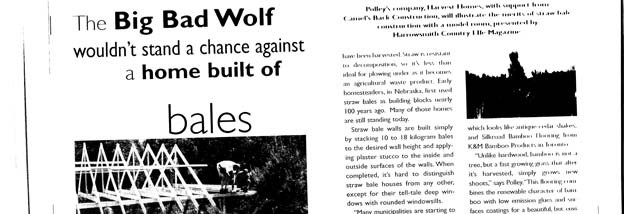The Big Bad Wolf wouldn’t stand a chance against a home built of bales – Fall Home Show 2001 Press Release
Straw bale construction is not only environmentally friendly, it offers two to three times greater insulation value than conventional construction, it’s more fire resistant and it’s affordable, as the bales provide both the wall system and insulation. Straw bales can also be used as infill for post and beam construction.
Straw is the stalk of cereal grains such as wheat, rye, barley or rice and it remains in the field after the grains have been harvested. Straw is resistant to decomposition, so it is less than ideal for plowing under as it becomes an agricultural waste product. Early homesteaders in Nebraska first used straw bales as building blocks nearly 100 years ago. Many of those homes are still standing today.
Straw bale walls are built simply by stacking 10 to 18 kilogram bales to the desired wall height and applying plaster stucco to the inside and outside surfaces of the walls. When completed, it’s hard to distinguish straw bale houses from any other, except for their tell-tale deep windows with rounded windowsills.
“Many municipalities are starting to accept straw bale homes, so they are starting to become more mainstream,” says Polley, who points out that in the past year, straw bale homes have been built in urban centres like Mississauga and Kanata. “They won’t cost more than a traditionally built home; they are super insulated and you can use any local farmers’ straw as long as it has no mold or mildew.”
It’s estimated that 1,000 straw bale homes were constructed in Canada last year.
The straw bale model will showcase two other environmentally friendly products as well: Wellington Polymer Techologies’ Enviroshake, a composite shingle made of scrap plastic, recycled rubber and cellulose hemp fibres which looks like antique cedar shakes. It will also showcase Silkroad Bamboo Flooring from K&M Bamboo Products In Toronto.
“Unlike hardwood, bamboo is not a tree, but a fast growing grass which it’s harvested, simply grows nesw shoots,” says Polley.’This flooring combines the renewable character of bamboo with low emission glues and surface coatings for a beautiful, but environmentally-friendly flooring option.”
Polley, who holds an honours Bachelor of Arts degree from Carlton University started Harvest Homes only two short years ago.
“My heart’s always been in treading more lightly on the planet and the move to Harvest Homes has been to something more grassroots,” he concludes with the satisfied tone of one who enjoys his chosen line of work.

